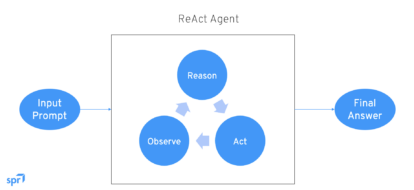Comparing ReAct and ReWOO: Two Frameworks for Building AI Agents in Generative AI
As generative AI continues to evolve, the concept of AI agents is gaining traction. These agents empower large language models (LLMs) to act autonomously, interact with their environment, and make decisions. While the term “agent” can mean different things to different people, at its core, an AI agent combines two critical capabilities: planning and interaction with the environment.
In this blog post, we’ll explore what AI agents are, how they function, and compare two of the most popular frameworks for building them: ReAct (Reasoning and Action) and ReWOO (Reasoning without Observation).
What Is an AI Agent?
AI agents are not new, but their role in generative AI solutions is rapidly expanding. At a high level, agents allow LLMs to go beyond static responses by enabling them to:
- Plan: Develop strategies to tackle complex problems via strategies such as chain of thought prompting.
- Interact: Use tools or knowledge repositories to respond to inputs dynamically.
An agent is, in essence, a combination of a planner and a set of tools. The degree to which these components are emphasized varies across different implementations.
How Do AI Agents Work?
AI agents typically consist of the following components:
- Generative AI Model: The LLM serves as the brain, handling planning, reasoning, and tool interactions.
- Planning Steps: The model generates a plan to achieve the user’s goal.
- Memory: The agent stores short-term and long-term context to enhance performance over time.
- Tools: Software functions or knowledge repositories the agent can leverage to interact with its environment.
The Process:
- The user provides a prompt to an LLM equipped with tool access.
- The LLM formulates a plan, often using chain-of-thought reasoning or a similar approach.
- The LLM executes the plan step by step, calling tools as needed.
- The process continues until the task is complete.
Popular Frameworks for Building Agents: ReAct vs. ReWOO
Among the many approaches to building agents, ReAct and ReWOO stand out as two of the most widely used frameworks. Let’s take a closer look at each.
ReAct (Reasoning and Action)
ReAct agents operate in a reason-act-observe loop, which repeats until the agent resolves the query. Here’s how it works:
- Reason: The AI analyzes the problem and devises the next best step.
- Act: The agent executes this step, often by calling a tool.
- Observe: The output of the action is analyzed, and the loop begins again.
This iterative process allows for dynamic decision-making and real-time adjustments based on feedback from the environment.
ReWOO (Reasoning without Observation)
ReWOO agents are structured differently, dividing responsibilities into three distinct components:
- Planner: Develops a complete plan at the outset, often encompassing multiple steps.
- Worker: Executes all steps in the plan, sometimes in parallel to save time.
- Solver: Compiles the results and formulates the final response to the user’s query.
ReWoo is more structured, aiming to complete tasks with minimal iteration by front-loading the planning process.
Tradeoffs Between ReAct and ReWOO
Both frameworks offer unique advantages and tradeoffs depending on the use case:
| Aspect | ReAct | ReWOO |
| Token Consumption | Higher, as it iteratively re-plans with each step. | Lower, due to single-step planning upfront. |
| Latency | Slower, as actions occur sequentially. | Faster, with potential for parallel execution. |
| Robustness | More adaptable to LLM updates and variations. | Fragile, as it relies heavily on predefined plans. |
| Dynamic Adjustments | Plans evolve with feedback during execution. | Plans are static and predefined. |
| Use Case Suitability | Best for open-ended or exploratory tasks. | Ideal for tasks requiring a strict, predefined plan. |
Conclusion
AI agents are transforming how we leverage generative AI, making LLMs more capable of handling complex, real-world applications. Whether you choose ReAct or ReWOO, understanding the tradeoffs of each framework will help you build agents tailored to your needs.
As the field of generative AI evolves, new frameworks and optimizations will emerge, further pushing the boundaries of what AI agents can achieve.





